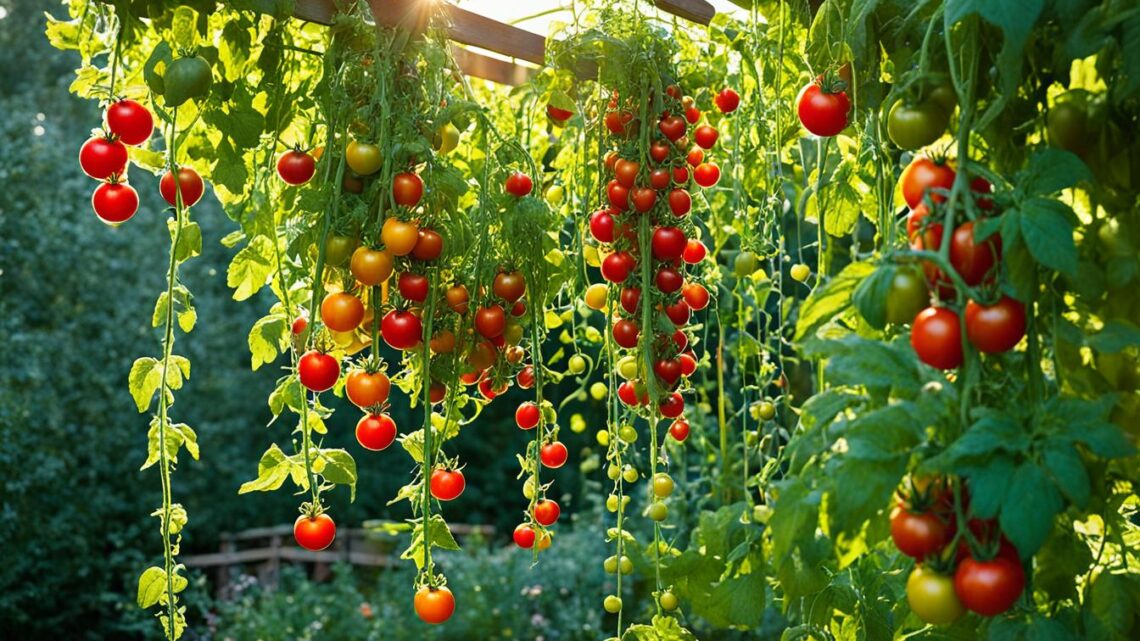
Are you ready to elevate your tomato-growing skills? Hanging tomato plants are a great way to use space wisely, especially if you have limited ground space. By growing your tomatoes vertically, you can enjoy fresh, tasty tomatoes without giving up valuable space. Let's explore how to grow these plants successfully.
Unveiling the Wonders of Upside-Down Tomato Gardening
Gardening lovers can find a great solution in hanging tomato plants and upside-down tomato gardening. This method lets you grow lots of juicy tomatoes in small spaces. It also means no more heavy staking.
Limited Space? No Problem with Hanging Tomato Plants
If you're short on space, like on a small balcony or rooftop, vertical tomato growing is perfect. Using tomato hanging baskets or tomato planters for small spaces lets you grow tomatoes easily. You don't need big garden beds or traditional in-ground gardening.
Bid Farewell to Staking Struggles with Upside-Down Tomatoes
Upside-down tomato gardening changes the game. Plants grow down, so you don't need to stake them. This saves time and effort. It lets your tomatoes grow freely without cages or stakes.
Trying hanging tomato plants and upside-down tomato gardening shows off modern gardening's creativity. It's great for those with little space or who want a better way to grow tomatoes. This method brings a lot of joy and a big harvest.
Preparing Your Hanging Tomato Masterpiece
Growing tomatoes in hanging baskets requires picking the right types and setting up your garden right. Cherry and grape tomatoes are great for hanging gardens. They have small fruits and vines that grow well in these spaces.
Choosing the Right Tomato Varieties for Hanging Gardens
For a successful hanging tomato garden, pick these varieties:
- Cherry tomatoes – These are perfect for hanging baskets. They produce lots of sweet, juicy tomatoes all season.
- Roma (or paste) tomatoes – Roma tomatoes grow well in hanging baskets. They give you a steady harvest of plum-shaped fruits.
- Tumbling or trailing tomatoes – These tomatoes are made for hanging. They have long vines that hang down, giving you lots of tomatoes.
Crafting Your Hanging Tomato Planter: DIY Options
For the planter, use a strong 5-gallon bucket or a pretty metal basket with coconut coir inside. It's important to have good soil, drainage, and balance for your tomatoes to grow well.
| Hanging Tomato Planter Features | Recommended Specifications |
|---|---|
| Planter Size | 5-gallon bucket or 14-inch decorative metal basket |
| Soil Type | Well-draining, nutrient-rich potting mix |
| Drainage | Multiple drainage holes in the bottom of the planter |
| Weight Distribution | Make sure the planter is hung securely to hold the soil, plants, and tomatoes |
Picking the right tomatoes and setting up a strong, well-thought-out planter will help you grow a great hanging tomato garden at home.
Hanging Tomato Plants: A Gardener's Delight
Growing tomatoes in hanging baskets or upside-down planters has many benefits for gardeners. It lowers the risk of pests and diseases by keeping plants off the ground. Hanging tomato plants also get better air circulation, which keeps them healthy.
These plants are perfect for small gardens, patios, and balconies. They grow vertically, fitting well in tight spaces. With proper care, hanging tomato plants can give you a great harvest.
The ‘Gardener's Delight' is a top choice for hanging baskets. It's sweet and has just the right amount of acidity. Gardener's Delight can grow as a cordon or bush type.
| Characteristic | Value |
|---|---|
| Average weight of individual Gardener's Delight tomatoes | 28g / 1oz |
| Tomatoes per truss | 10 to 14 |
| Tomatoes per plant | 70 to 80 |
| Brix rating for sweetness | 7.0 |
Use a 35cm wide planter filled with about 8 liters of compost for Gardener's Delight tomatoes. Plant them in early summer to skip frost damage. Water them every day for the first week to help them grow strong.
Gardener's Delight is great for gardeners with little space. This method lets you enjoy tasty, sweet tomatoes from your patio or balcony.
Nurturing Your Hanging Tomato Oasis
Proper care and maintenance are key for watering hanging tomato plants. These plants dry out fast, especially in hot weather. So, water them every day, or twice a day in very hot or dry times.
Feeding your hanging tomato plants is also crucial for a good harvest. Use a balanced, water-soluble fertilizer every two weeks. This helps them grow strong and produce lots of fruit. With regular watering and feeding, you can have a great hanging tomato oasis that gives you lots of tasty tomatoes.
Watering Wisdom: Keeping Your Hanging Tomatoes Hydrated
Tomatoes in containers need water every day because they dry out quickly. Make sure to water your hanging tomato plants at least once a day. During very hot or dry times, you might need to water them twice a day.
Feeding Your Hanging Tomato Plants for Bountiful Harvests
Give your hanging tomato plants a balanced, water-soluble fertilizer every two weeks. This keeps them full of the nutrients they need for healthy growth and lots of fruit. It helps with strong leaves, roots, and a big harvest.
By taking care of your watering and feeding needs, you can have a great hanging tomato oasis. You'll get a lot of juicy, homegrown tomatoes to enjoy.
Reaping the Rewards: Harvesting Your Hanging Tomato Treasures
When your hanging tomato plants start to ripen, it's time to harvest. Keep an eye on them and pick them when they're ready. Twist and pull the tomatoes gently from the vine without hurting the plant. Harvesting often will make your plant produce more throughout the season.
Your hanging tomato garden will give you fresh, tasty tomatoes all summer. Having these fruits right at your fingertips is very rewarding. Enjoy the sweet taste of your tomatoes, knowing you grew them in your small space.
Harvesting your tomatoes lets you appreciate your gardening work. You've put in time and effort, and now you get to enjoy the tasty results. Share your homegrown produce with loved ones. Every ripe tomato reminds you of the beauty of growing your own food in a small space.






